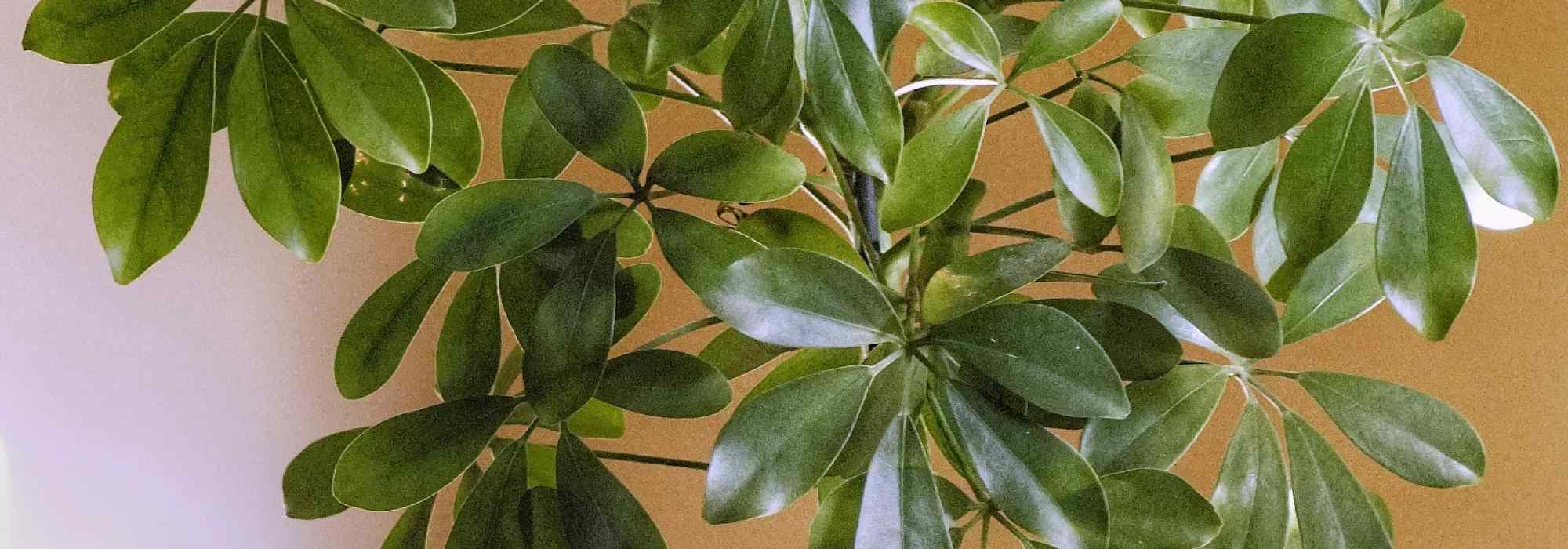
Schefflera: Care, Propagation by Cuttings, and Cultivation Tips
Contents
Schefflera in a nutshell
- It combines elegance and simplicity
- Its green, graphic, glossy leaves resemble small parasols
- It brings a breath of exotic freshness and helps purify indoor air
- It enjoys bright light, moderately dry air, and moderate watering
- Easy to care for, it’s a good green plant for beginners
A word from our expert
The Schefflera, commonly known as the “umbrella tree,” is a houseplant highly valued for its elegant habit and striking foliage. Its green leaves, which are compound and glossy, arranged in an umbrella shape, immediately evoke the exoticism of the tropical forests of Southeast Asia, its native habitat. There are even variegated Schefflera varieties, such as Schefflera ‘Gold Capella’!
With its graceful and dense silhouette, it adds structure and freshness to any living space. Due to its moderate growth and ability to adapt to the light conditions of workspaces, the Schefflera arboricola has earned the nickname “office tree.”
This easy apartment plant also charms with its low maintenance requirements. Moderate watering, allowing the substrate of the schefflera to dry on the surface between waterings, is sufficient to maintain its brilliance. Little susceptible to diseases, the Schefflera is a robust green plant.
To successfully care for the indoor schefflera, it is essential to meet its light and water needs while ensuring a good repotting every two to three years. Propagating the schefflera in water is also a simple and effective method to multiply this tropical plant, ideal for greening a living room, office, or conservatory. It is also recognised as a pollutant-filtering plant that helps purify indoor air.
Let yourself be charmed by this resilient and low-maintenance green plant!
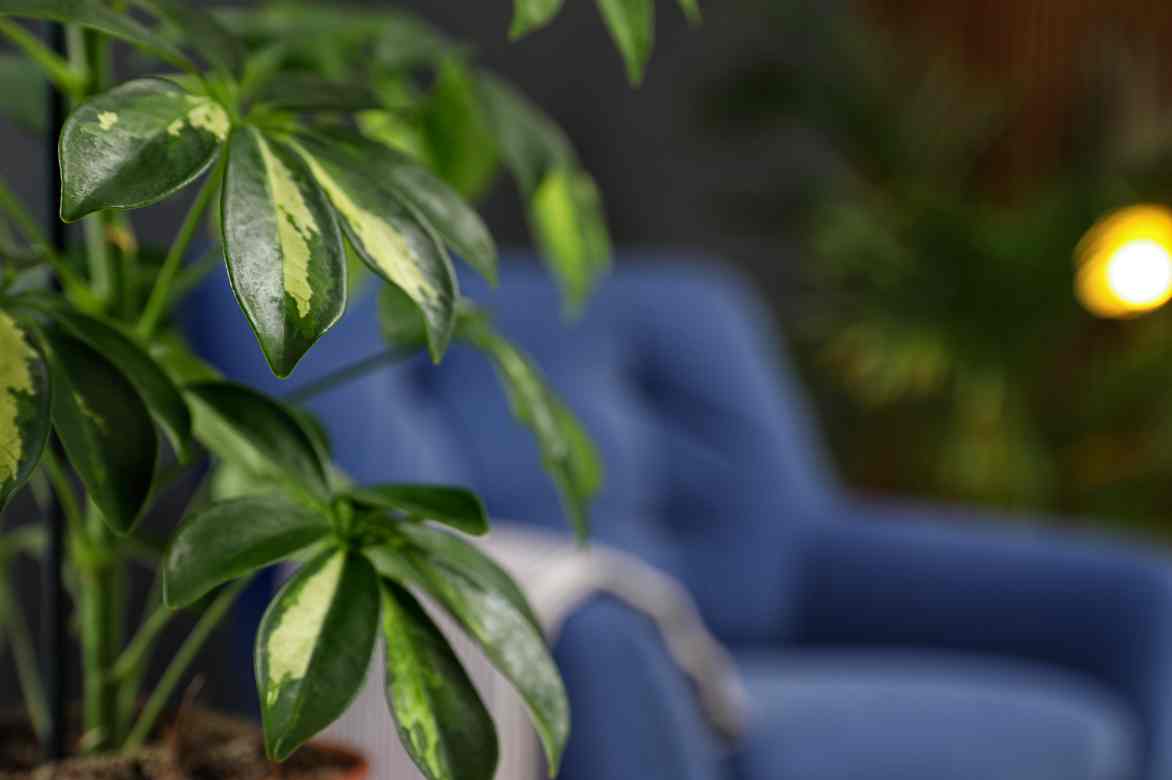
Schefflera, commonly known as the umbrella tree, is a popular houseplant appreciated for its lush, glossy foliage. This tropical plant features large, palmate leaves that can grow up to 12 inches long, creating a striking visual appeal. Schefflera thrives in bright, indirect light but can tolerate lower light conditions, making it versatile for various indoor environments. It prefers well-draining potting soil and should be watered when the top inch of soil feels dry. Overwatering can lead to root rot, so it's essential to ensure proper drainage. Regular pruning helps maintain its shape and encourages bushier growth. In terms of care, Schefflera benefits from occasional fertilisation during the growing season and should be kept in a warm environment, away from cold drafts. This resilient plant can grow quite tall, making it an excellent choice for adding height to indoor spaces.
Botanical data
- Latin name Schefflera
- Family Araliaceae
- Common name Dwarf umbrella tree, Schefflera, Umbrella tree, Parasol tree
- Flowering Rare indoors
- Height Between 1 and 2 m
- Exposure Moderate light, Bright indirect light
- Soil type Light potting mix, Well-draining potting mix
- Hardiness Frost-sensitive
The indoor Schefflera belongs to the botanical family Araliaceae, which includes many tropical species such as Fatsia japonica. This plant is commonly referred to as “umbrella tree”, “parasol plant”, “dwarf umbrella” or “parasol tree” due to the characteristic appearance of its compound foliage, with leaflets radiating from a central point, resembling the structure of an umbrella.
The Schefflera originates from the tropical and subtropical regions of Southeast Asia and Oceania, particularly in China, Taiwan, Indonesia, and as far as New Guinea. In its natural environment, this plant thrives in the lower or middle layers of humid tropical forests, where it benefits from the filtered light that penetrates the canopy and a consistently warm and humid atmosphere. It sometimes develops aerial roots, allowing it to anchor to tree trunks and better capture ambient moisture, a mechanism typical of species adapted to tropical understories. The species name arboricola literally means “living in trees”. It refers to this partially epiphytic lifestyle observed in its natural state. In its native habitat, it frequently colonises tree trunks or cavities, using vertical structures to rise in search of light while remaining rooted in the organic matter accumulated above.
The genus Schefflera comprises around 150 species and 900 varieties. While Schefflera is commonly cultivated in our latitudes as a houseplant, this is mainly due to its sensitivity to cold. Only three species have been selected for their ornamental qualities and relative ease of care. The most commonly cultivated species indoors are:
- Schefflera arboricola (syn. Heptapleurum arboricola) : the most widespread species indoors, valued for its compact habit, (dwarf umbrella tree) and its foliage composed of shiny, dark green or variegated leaflets. It reaches 1 to 2 metres in height indoors depending on growing conditions.
- Schefflera actinophylla: a larger species, suited for spacious environments. Its more imposing and spreading foliage can reach up to 3 metres in height indoors.
- Schefflera ‘Amate’: a cultivar selected for its particularly large, glossy foliage and vigorous growth. Particularly suited for bright interiors.
- Schefflera ‘Gold Capella’: a variegated cultivar with dark green leaves marbled with yellow, highly valued for its decorative appearance and ability to brighten sparsely vegetated spaces.
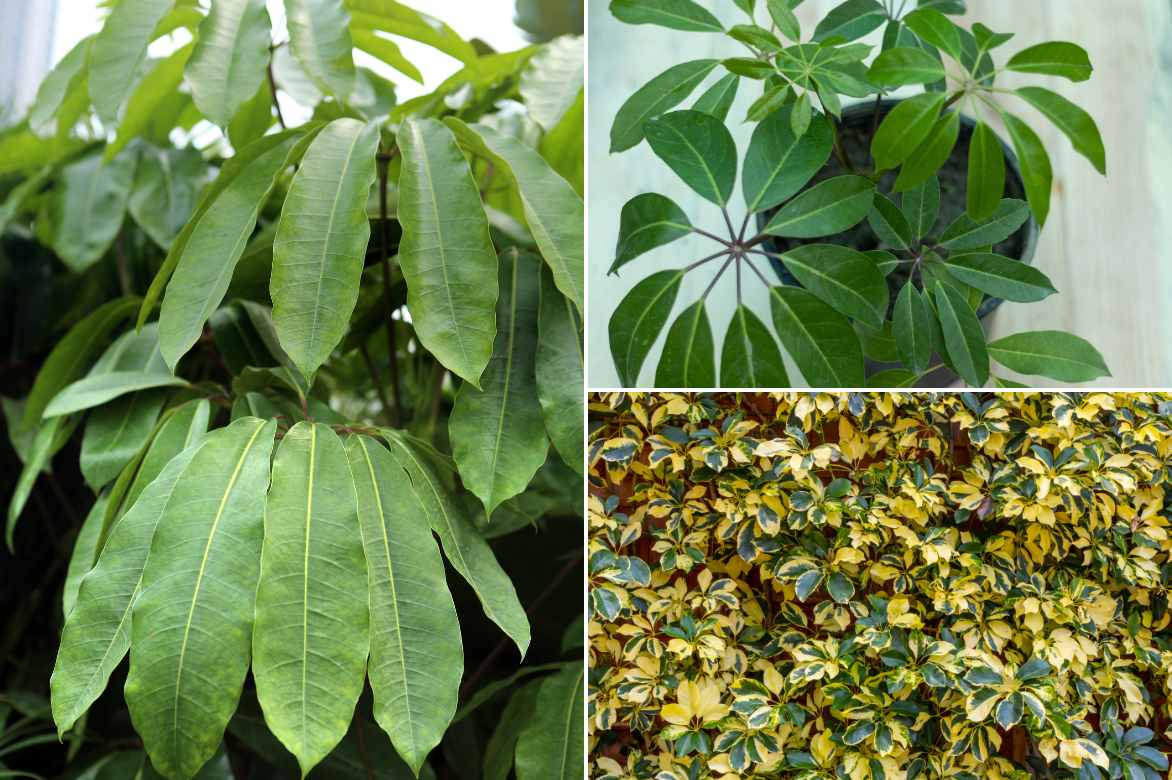
Schefflera actinophylla, Schefflera ‘Amate’ and Schefflera arboricola
The Schefflera arboricola appears as a bush with a naturally bushy and upright habit, which can take on a more branched and spreading silhouette with age. Under optimal growing conditions in its natural environment, it commonly reaches three to four metres in height, although its growth is more moderate indoors, where it rarely exceeds 1.5 metres, or even two metres for the oldest specimens or those grown in large containers. On average, it can grow 20 to 30 cm per year, depending on exposure, watering, and substrate quality.
Its root system is fasciculate, dense, and shallow, with the ability to produce aerial roots in sufficiently humid environments, allowing the plant to anchor to vertical supports or stabilise its habit in light soils. The branches are distributed irregularly from the central trunk, forming an open structure, sometimes slightly trailing at the periphery, depending on growing conditions.
The leaves are evergreen, alternate, and palmately compound, borne on long petioles that can reach 20 to 30 centimetres. Each lamina is divided into 7 to 9 leaflets arranged in a rosette around the tip of the petiole, giving the plant its characteristic umbrella-like appearance. The leaflets, elliptical to oblong in shape, measure 8 to 15 centimetres in length and have an entire margin and a leathery texture. The upper surface is glossy, with a uniform dark green colour, while some horticultural varieties may display cream or light green variegation. The underside is slightly paler, with a marked central nervature.
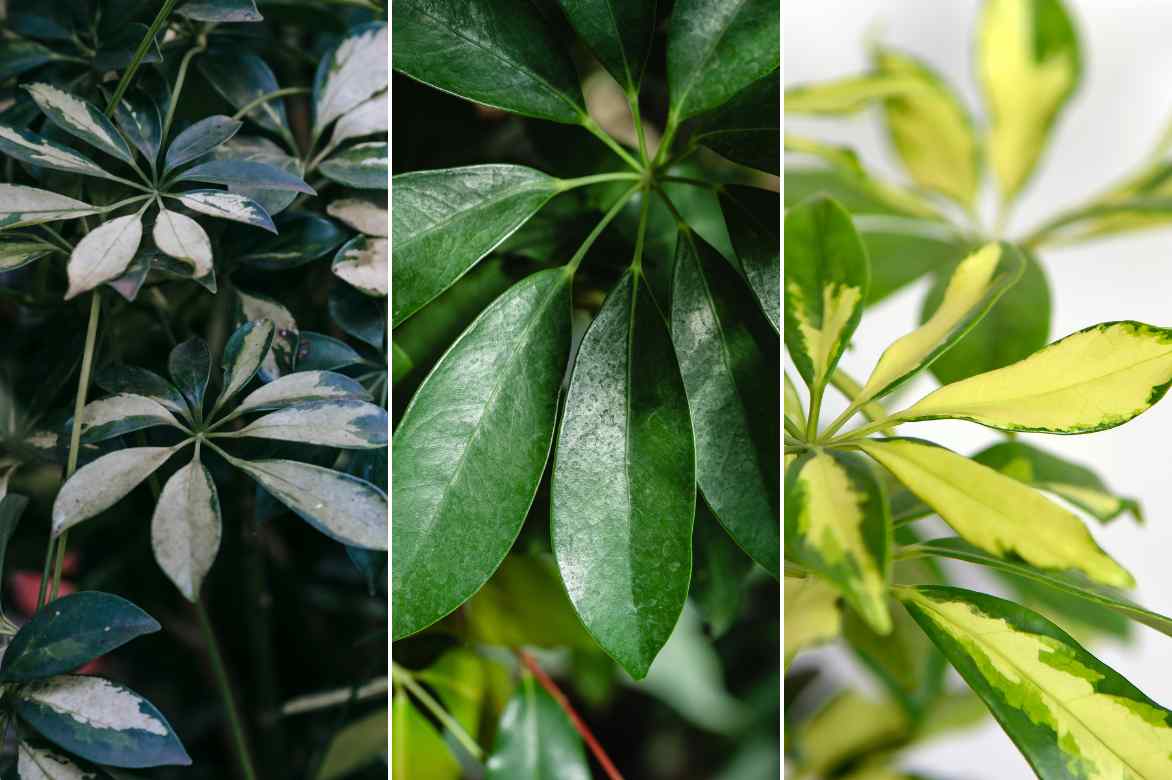
Foliage varies from solid to various variegated forms
The flowering of Schefflera is exceptional in indoor cultivation and is generally absent under these conditions. In its natural environment or under tropical greenhouse conditions, the plant can produce terminal inflorescences in erect panicles, consisting of small, greenish to yellowish flowers, lacking real ornamental value. Each flower is composed of five discreet sepals and petals, arranged in a secondary umbel at the tips of the floral branches.
Fruiting, rarely observed outside its native habitat, results in small, fleshy, spherical berries that turn red at maturity. These fruits contain several small seeds and contribute to the dissemination of the species in the tropical ecosystems where it is native.
Like many tropical evergreen plants, it is a pollutant-absorbing plant that helps purify indoor air by absorbing certain pollutants present in our homes, including formaldehyde, benzene, and toluene, which come from building materials, paints, or household products.
Species and varieties of Schefflera
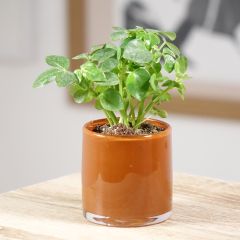
Schefflera arboricola - Umbrella tree
- Height at maturity 2 m
Planting the schefflera
Where to Place the Schefflera in the House?
The Schefflera thrives indoors when it receives abundant but diffuse light. It should be positioned near a window facing east or west, where it will get enough brightness without direct exposure to sunlight, especially during midday. Insufficient light leads to a stretched and sparse habit, while direct sunlight can cause leaf burn. The room should maintain a temperature between 18 and 25 °C, (>15°C for a warm greenhouse, >20°C for a tropical greenhouse), avoiding temperature fluctuations, drafts, and direct heat sources. A moderate to high humidity level (40-80%) is recommended, particularly during the winter heating season, to prevent leaf desiccation. The Schefflera is ideally placed in a living room, an office, a bright bedroom, or a temperate conservatory, provided that direct sunlight and drafts are avoided. You can move your green plant outside in summer, as long as it is placed in partial shade and brought back in when temperatures drop below 15 °C.
The Schefflera adapts slowly to environmental changes; any sudden shift in exposure or temperature can disrupt its growth. Finally, ensure there is enough space in height and width, especially for mature specimens, so that the plant’s natural habit is respected and its development is not constrained.
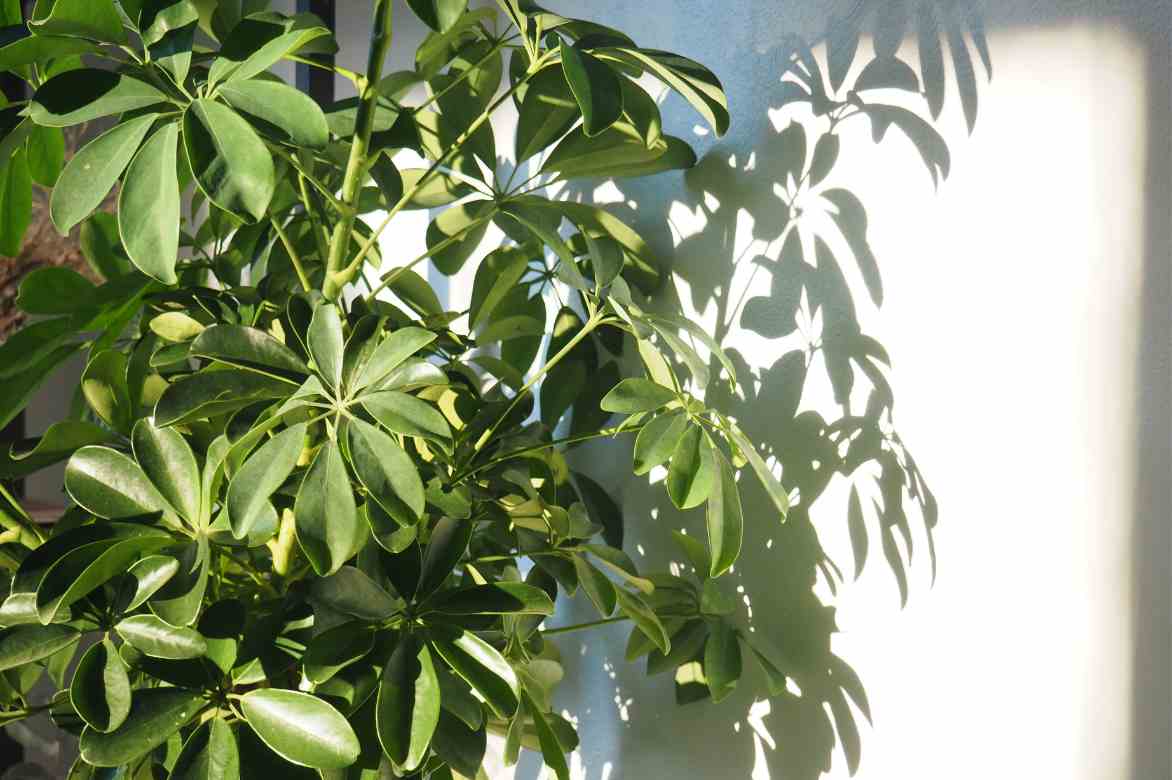 Choose a bright location without direct sunlight
Choose a bright location without direct sunlight
When to Plant or Repot the Schefflera?
Planting or repotting the Schefflera is preferably done in spring, which corresponds to the resumption of vegetative growth. However, indoors, it is possible to intervene throughout the year. Our plug plants should be installed upon receipt, without delay, to encourage rooting and proper development of the plant.
The Substrate for the Schefflera
Schefflera arboricola prefers a light, well-draining substrate rich in organic matter. To ensure good growing conditions indoors, it is advisable to prepare a balanced mix composed of:
- 60% of potting soil for indoor plants
- 30% of perlite or vermiculite to promote drainage and aeration
- 10% of mature compost or sifted leaf mould to enrich the substrate with nutrients
This mix provides a stable, permeable, and sufficiently nutritious substrate, limiting the risks of water stagnation and root rot. Installing a drainage layer (clay balls or gravel) at the bottom of the pot is essential.
How to Plant and Repot the Schefflera?
The container must be perforated to ensure excess water drainage.
Steps for planting or repotting:
- Choose a perforated pot, with a diameter slightly larger than that of the root ball (for a plug plant, a pot with a diameter of 7 to 9 cm is suitable)
- Place a drainage layer at the bottom of the pot.
- Partially fill the container with a light and fertile substrate.
- Position the plant, ensuring the collar is level with the substrate, without burying it.
- Fill in with substrate, lightly compacting to stabilise.
- Water moderately, then allow the top layer of substrate to dry before the next watering.
- Avoid stagnant water in the saucer.
- Renew the substrate every two to three years or perform annual top-dressing for large plants that are difficult to move.
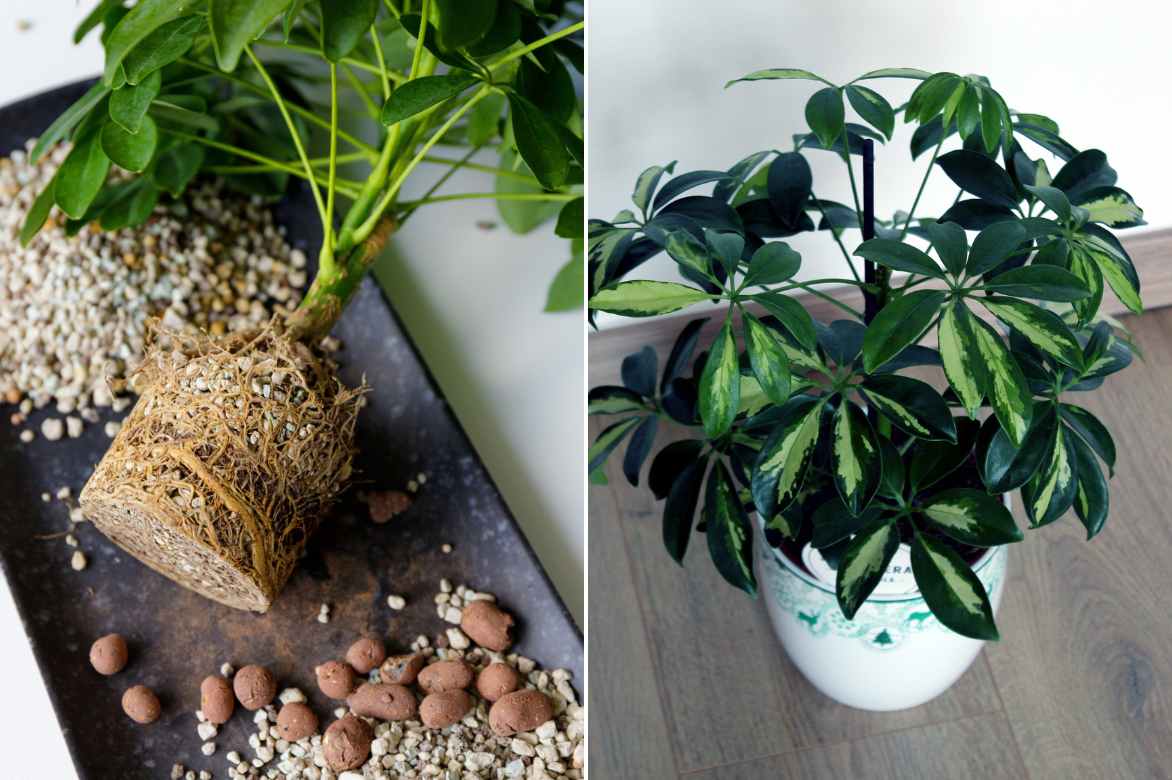 The root condition in this example requires repotting. The perforated pot is placed in a cache pot for indoors
The root condition in this example requires repotting. The perforated pot is placed in a cache pot for indoors
Care tips and maintenance for Schefflera
Watering
The Schefflera requires moderate and well-managed watering. It needs little water. It is essential to allow the top layer of the substrate (about the first 2 to 3 centimetres) to dry out between waterings to avoid root asphyxiation and the risk of rot.
During the growth period (spring and summer):
- Water approximately once a week, depending on the temperature and ambient humidity.
- Allow excess water to drain and systematically empty the saucer after watering.
During the resting period (autumn and winter):
- Reduce watering to once every 10 to 15 days, or even less, depending on the indoor temperature.
- Never water systematically; always check the moisture of the substrate beforehand.
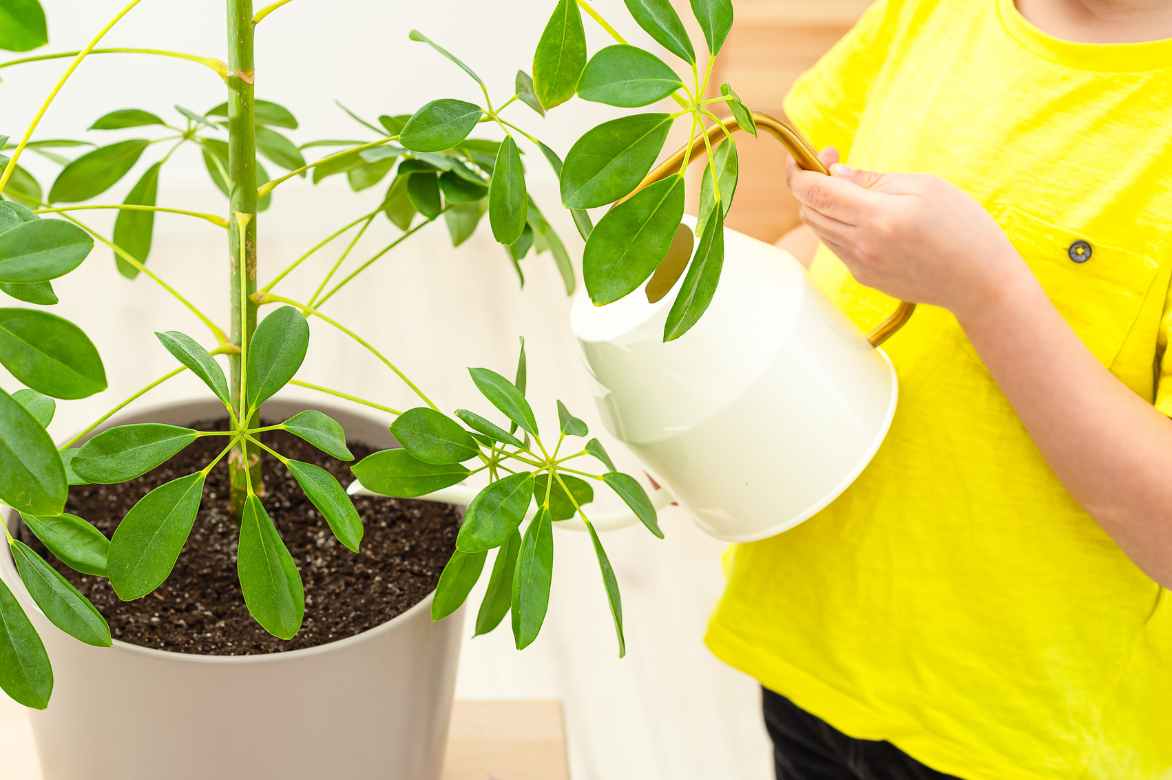
Water regularly, without excess
Humidity
The Schefflera enjoys a slightly humid atmosphere. Occasional misting of the foliage can be done, especially in winter, to limit the drying of the tips and prevent the appearance of red spider mites.
- Avoid excessively wetting the foliage in very dry air to prevent fungal diseases.
- Grouping several plants can help create a more favourable microclimate.
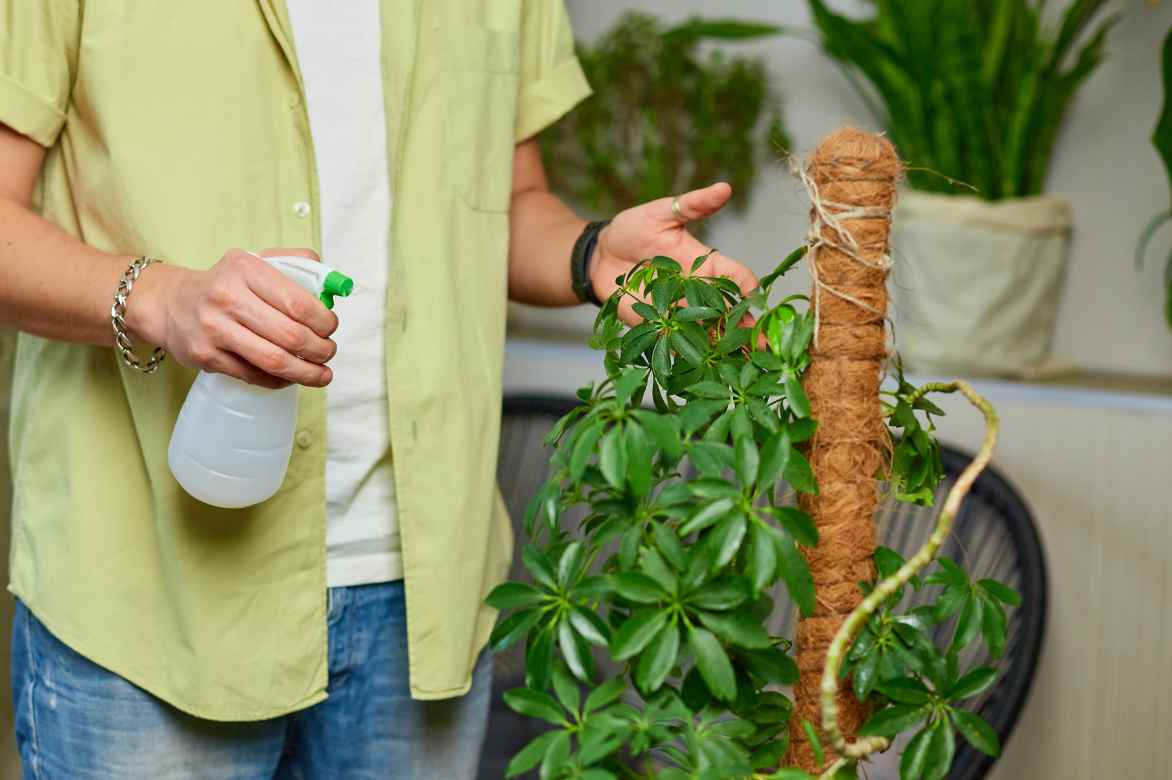
Especially in dry interiors, remember to mist your plant
Leaf Cleaning
Clean the leaves of the Schefflera arboricola with a soft, damp cloth to remove dust and maintain their shine.
Fertilisation
- Use a liquid fertiliser for flowering or green plants with a balanced formulation (NPK 10-10-10) every 4 to 6 weeks from spring until the end of summer. No fertiliser is needed in autumn and winter when the plant is in a vegetative resting phase.
How to Prune a Schefflera?
The Schefflera tolerates pruning well, which helps control its growth and encourages branching:
- Prune preferably in spring, reducing overly long or unstructured stems.
- Remove yellowed or damaged leaves as needed to maintain its decorative appearance.
- Pinch the main stem to encourage branching and achieve a bushier plant. Pruning wounds heal quickly, but it is advisable to use clean, disinfected tools. Handle with gloves if necessary: the latex in the stems can be slightly irritating to the skin for sensitive individuals.
Repotting the Schefflera
Repotting is necessary to maintain the plant’s vigour. Repot every 2 to 3 years, ideally in spring, into a slightly larger container (3 to 5 cm in diameter) than the previous one and in a light, draining substrate. For large specimens that are difficult to move, perform a top dressing by renewing the top 3 to 5 cm of substrate each year. You can learn all about repotting in our article: How to repot a houseplant?
Special Precautions
- Avoid excess water, the main cause of decline indoors.
- Do not suddenly expose the plant to full sunlight, especially after repotting or pruning.
Schefflera Indoor Diseases
The Schefflera is generally resilient indoors, but certain cultural mistakes can encourage the appearance of parasitic pests or diseases.
- Mealybugs: remove them manually using a cotton bud soaked in 70° alcohol. For more details: Mealybugs: identification and natural treatments.
- Red spider mites: increase humidity around the plant and treat with a homemade solution of black soap. For more details: Red spider mites: identification and treatment.
Regarding diseases, excess water remains the main risk factor, promoting root rot and the appearance of fungi responsible for spots on the leaves. Moderate watering and well-drained soil are usually sufficient to limit these issues.
| Symptoms | Probable Cause | Solution |
|---|---|---|
| Yellow leaves falling | Excess water | Reduce watering |
| Pale leaves, slow growth | Depleted soil | Add fertiliser or repot |
| Leaves falling, dry soil | Plant exposed to cold | Move to a warmer location |
| Stretched stems, spaced leaves | Lack of light | Relocate to a brighter spot |
| Black base, wilting | Roots rotting | Stop watering, repot in healthy soil |
| Cottony masses, small shields | Mealybugs | Clean and treat |
| Fine webs, discoloured leaves | Red spider mites | Increase humidity, treat if necessary |
→ Learn more in our article dedicated to diseases and pests of the Schefflera.
Propagate the Schefflera
The Schefflera is propagated by cuttings of semi-woody stems, taken in spring or summer.
How to propagate a Schefflera in water?
The Schefflera can be propagated by cuttings in water. Simply take a semi-woody stem of 10 to 15 cm, bearing several nodes, and place it in a glass of room temperature water. The water should be changed regularly to prevent mould development. When the roots reach about 3 to 5 cm, the cutting can be transplanted into a light, well-draining substrate.
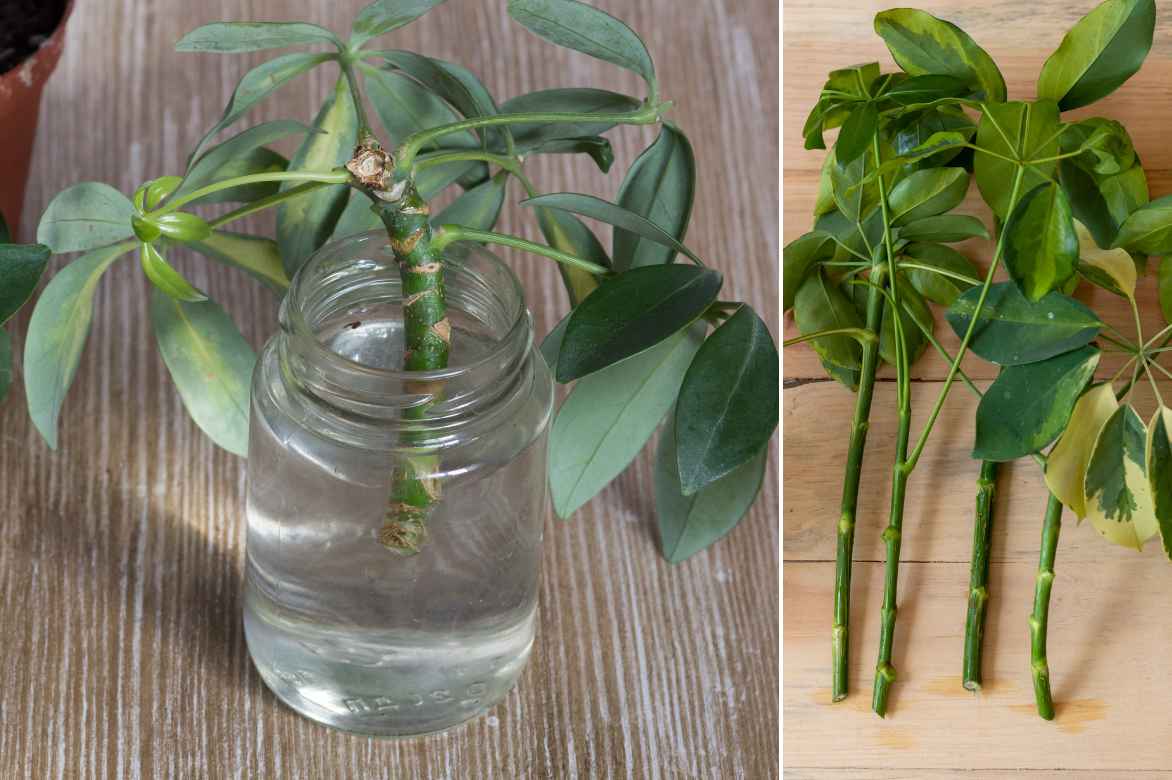
Cuttings in soil
- Take a semi-woody stem of 10 to 15 cm, bearing several nodes.
- Remove the lower leaves.
- Plant the base of the stem in a light mixture, formed of potting soil and perlite or coarse sand.
- Keep the substrate slightly moist without excess.
- Place under a mini greenhouse or cover with a transparent plastic bag to retain moisture.
- Ventilate often and maintain at room temperature until rooting occurs.
Associations and Decor
The Schefflera easily finds its place in a bright interior, where it adds height and volume without weighing down the space. To highlight its umbrella-like foliage and graphic habit, it is wise to place it in a corner of the room, in a large raw terracotta pot or in a rattan cache-pot, which will showcase its natural side.
Ideal in a spacious living room or a well-lit office, it thrives near a window facing east or west, where the light is abundant yet filtered.
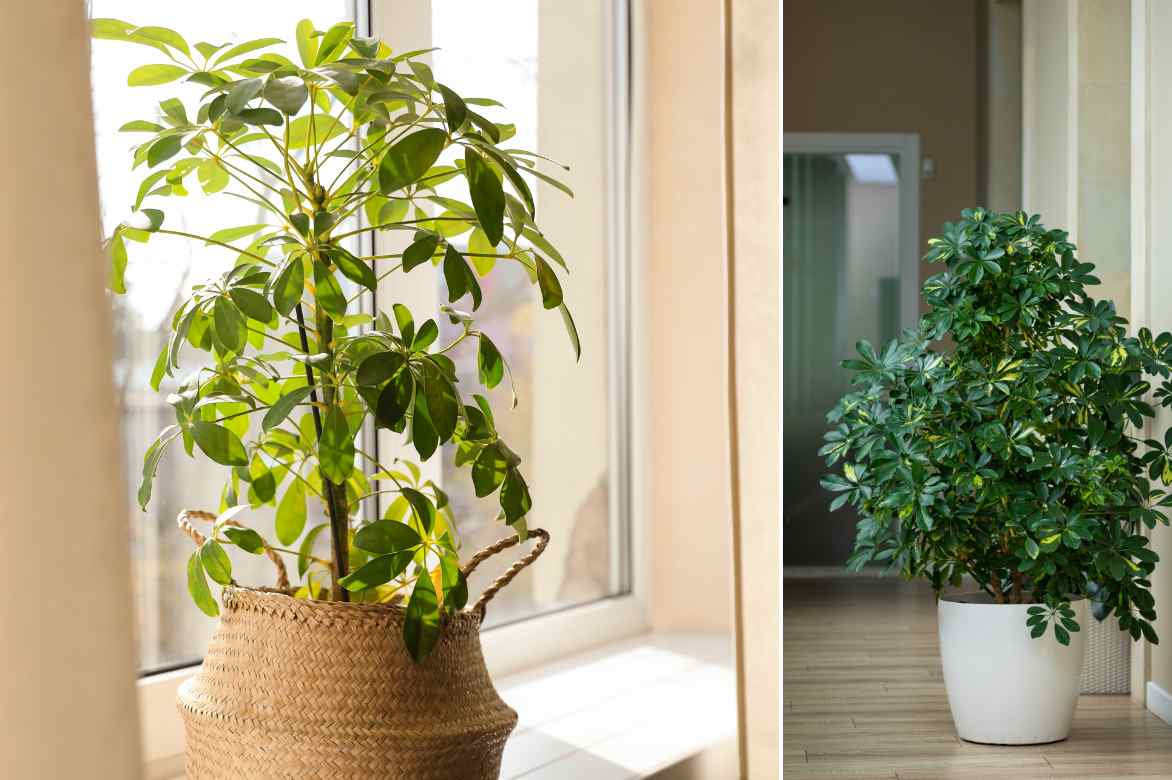
In a fibre cache-pot or a neutral pot, the Schefflera enjoys bright interiors
The Schefflera can be paired with species that have contrasting foliage to create a chic jungle corner. Instead of the classic Ficus, combine it with a Calathea orbifolia, whose large satin leaves soften the composition, or with a Dracaena marginata, whose long linear leaves bring lightness and verticality. It can also be integrated into a group that includes a Peperomia with fleshy, glossy leaves.
For a beautiful tropical effect, add a Monstera deliciosa with its large, split leaves. Finally, for a more contemporary and minimalist atmosphere, place some Sansevieria nearby.
Also to read
→Discover our wide range of houseplants
→Our decorative foliage houseplants and our flowering houseplants
→Our books on houseplants
Frequently asked questions
-
My Schefflera is losing its leaves.
If your Schefflera is losing its leaves, it is often related to overwatering, a lack of light, or a cold draft. Consider adjusting the watering and placing the plant in a bright location, sheltered from temperature fluctuations.
-
What to do if the Schefflera turns yellow?
If your Schefflera is turning yellow, several causes are possible:
Excess water: allow the surface of the soil to dry before the next watering.
Lack of light: move the plant closer to a well-lit window, avoiding direct sunlight.
Depleted soil: consider adding fertiliser or repotting if the compost is old.
Yellowing is often a signal that maintenance needs to be adjusted.
- Subscribe!
- Contents
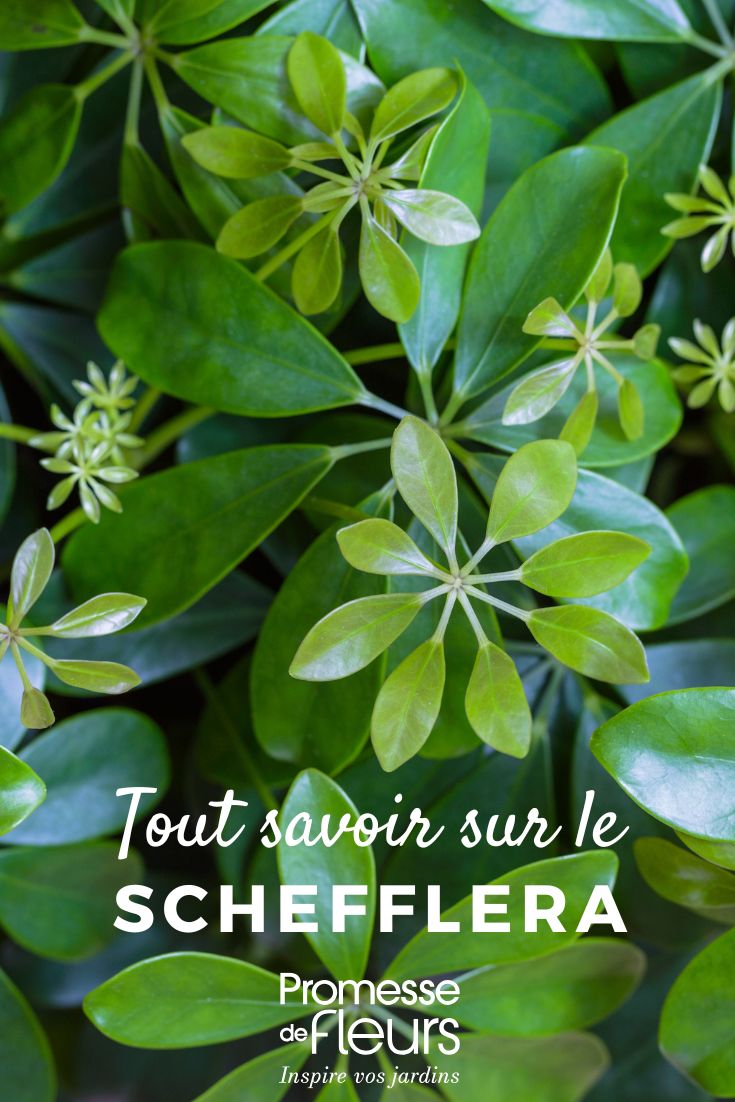































Comments